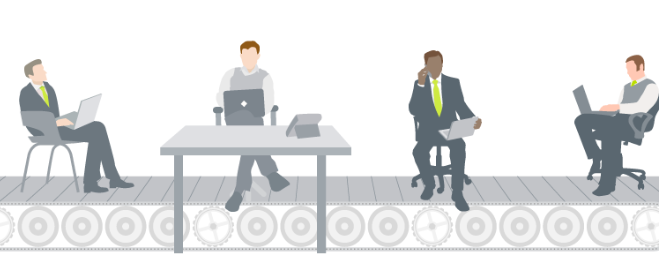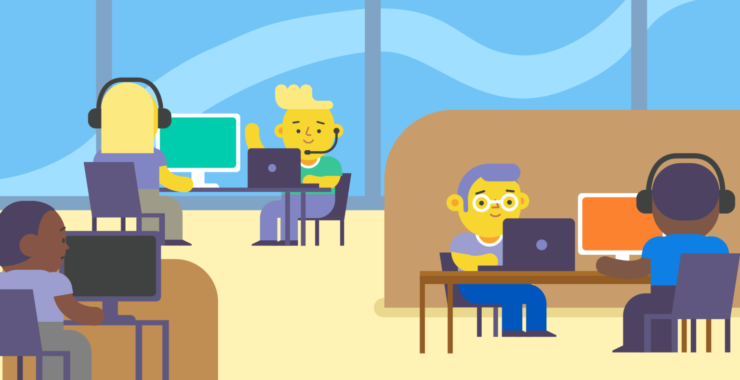The flexibility and the benefits of remote work have made it a preferred working model in the present day. Employees want to avoid dealing with morning traffic and chaotic workspaces again. On the other hand, employers save big by not renting or owning large offices that require heavy operational overheads.
For those starting a business in 2025, hot desking can help save big for bootstrapping startups. Many new businesses are reconsidering hot desks and other forms of flexible seating to better suit new methods of working and stay cost-efficient.
Ask yourself whether hot desking fits in with your company’s business goals and if it can adapt to the changing demands of your workforce before you commit to a certain workplace plan.
However, remote working only partially replaces the benefits of the office environment. For instance, office spaces offer better collaboration, enhanced work tracking, and monitoring, and water cooler breaks that drive impulsive brainstorming opportunities. In spite of these things, if you chose remote working or freelancing, you should know that there are the best freelance websites and once registered there, you can start looking for best fitting jobs.
Companies have found a mid-way solution to this by adopting hybrid work. A report suggests that 63% of high-revenue growth companies embrace this model. And this has led to a rise in hot desking as the answer to hybrid working.
What is hot desking?
Hot desking is a model where employees claim an available desk, unlike the traditional model where they are assigned a desk. For example, WeWork adopts a hot desking system where workers take any available desk and sign up for a shift upon arrival at the office. Hot desking has also gained popularity in private offices to use office spaces efficiently.
Moreover, 37% of global organizations plan to increase their use of co-working or flex space after the pandemic.
While hot desking helps employees choose where to sit based on available desks, you’ll still need a functional system to manage and implement it. Major companies like Deloitte and Microsoft have effectively implemented hot desking, improving communication and collaboration that requires adopting advanced tools adopting. Failure to have the proper management and implementation can lead to disgruntled employees.
Advantages of hot desking to modern workplaces
Hot desking comes with a host of benefits that can help increase flexibility and efficiency in the workplace. Allowing your employees to choose where they will sit every day can help companies save money and create a more energetic, collaborative atmosphere.
- Reducing Real Estate Costs
One of the most attractive reasons for hot desking, though, is that it saves money by reducing real estate expenses: with no need to have dedicated workspace for every employee, one can shrink the size of the office and only pay for the space utilized. This model will be a fit for any startup and entrepreneur eager to save on everything possible while still being present in a professional, well-equipped workspace. - Fostering a More Dynamic Work Environment
Hot desking offers an open and flexible work environment whereby the employees are encouraged to interact with different colleagues and departments. This encourages teamwork and sharing of ideas that can result in creative solutions and innovation. When individuals sit at different locations each day, they get the opportunity to work with new team members, sparking fresh ideas and perspectives. - Agile Workspace for Flexibility
Hot desking enables an agile approach to office space management in view of changing business needs. It also allows businesses to adapt more easily to fluctuating demands, such as project deadlines or special events, with the ability to extend or contract office size and layout based on employee numbers and activity requirements. This can help them move ahead in today’s world of fast-tracking business activities. - Hybrid and Remote Working Support
While hot desking most definitely meets their needs today, the continuing prevalence of remote and hybrid work models provides a frictionless solution to incorporating remote employees into the office environment. Employees can book desks as needed and still have many of the social and collaborative advantages of in-office work-all without logistical headaches and permanent seating. This supports inclusivity and work-life balance for those employees working from home one day and in the office the next.
Common disadvantages of hot desking
While hot desking has numerous advantages, there are also some cons to be considered. The more the business knows about these issues, the easier it will be to tackle them proactively and make the transition to hot desking smooth and enjoyable for the employees.
- Employee Dissatisfaction
One of the biggest complaints about hot desking is that it can be frustrating for employees not to have a permanent, personal workspace. Some people cannot “settle in” and make their workspace their own, which can make them feel uncomfortable and disconnected. To mitigate this, employers can allow employees to have designated “home bases” or “zones” within the office to create ownership while still maintaining the flexibility aspect of hot desking. - Lack of Personal Space
Where desk allocations are not allowed, several of the employees are suffering with issues of no place being assigned as personal to keep some valuable belongings or to plan work. Packing everything almost after and before work is cumbersome to expect from people, specifically the ones who want an even environment to plan longer versions of projects. Instead, lockers or someplace for personal storage may deal with this problem to assure comfort and security among all employees in the workplace. - Hygiene and Cleanliness Issues
With hot desking, not having workstations can be a concern in terms of cleanliness and hygiene. Workers may be worried with sharing desks with other workers and whether the space is cleaned between use. Regarding this issue, businesses have to implement cleaning protocols wherein desks and common areas should be regularly disinfected. Also, providing cleaning supplies, such as wipes or hand sanitizers, enables the employee to take care of his workspace. - Security and Privacy Issues
Other drawbacks of hot desking are possible security and privacy issues. Employees may be apprehensive about leaving sensitive work materials behind or about these being accessed inadvertently by others. In this regard, the employer can provide secure storage facilities, like lockable cabinets or safes, and implement clear guidelines for the management of confidential information in a shared workspace. - Complexity of Booking System
Without an effective system to handle desk reservations, hot desking can be a recipe for confusion and frustration. Employees can show up to find that their preferred desk is taken or fiddle with the complexity of booking systems. Companies should invest in intuitive hot desking software that allows employees to quickly reserve and check desk availability in real time, guaranteeing a seamless and stress-free experience for all.
How does hot desking work?
According to Forbes, 61% of employees preferred working remotely, while 97% preferred flexibility between remote working and office spaces. Such a growing trend indicates that flexible working is the future approach to employment. And here, hot desking can open floodgates of advantages for organizations, as they can now downsize office spaces or even implement full-time remote working.
With organizations choosing this model, 77% of businesses use such opportunities to include hot desking. This will cut real estate costs and operational workings. This is because hot desking allows organizations to manage working spaces at lower costs.
Let us now explore some key aspects of hot desking, and businesses will benefit from adopting it moving forward.

goto.com
Booking meeting rooms have become flexible
The growing trend of hot desking demands streamlining the bookings. Offer smart office solutions through apps and web platforms to book hot desks, and reserve conference rooms and other facilities.
The offices that offer hot-desking solutions provide users and clients (companies) with reservation platforms that indicate whether a desk is booked to help in booking and managing schedules.
This helps set flexible schedules depending on the availability of desks to avoid double booking. It can also help manage available resources better.
Accessibility to power outlets and phone booths
Hot desk facilities have several power outlets, USB ports, and internet ports for convenience and ease of use. It is because employees won’t have fixed workspaces, so any available spaces should be able to accommodate their needs. A phone booth also allows users to take or receive calls in a private environment.
Hot desk facilities can also include common lounges to network and hold a casual meetup without fuss.
Technology and internet
Almost all the users leveraging hot desk facilities are well-equipped with laptops and smartphones. As such, all hot desking facilities should have Wi-Fi to help people access the internet in the office.
Also, some employees may need different devices when working. Therefore, your hot desking facilities can also include VGA (Video Graphics Array), DVI (Digital Visual Interface), or HDMI (High-Definition Multimedia Interface) connections and extra monitors. This allows employees to access second screens when working.
Personal storage space
Another major feature of hot desking facilities is that they provide personal storage spaces. Employees can temporarily leave their belongings, such as when attending meetings or going out on a break or lunch. Try providing cubbyholes or safe lockers to employees.
Reasons to use hot desking
Business owners always look for ways to improve employee productivity. Hot desking offers ways to mitigate expenses and yet boost productivity.
- Improve employee satisfaction: Hot desking comes to the rescue for employees who don’t have a permanent desk or workplace. Research suggests that 46% of workers feel more productive in a hot desk environment. That’s because they don’t have as much time to get distracted by personal projects or other tasks that may not be related to their job KPIs.
- Enhance collaboration: Hot desking enables employees to collaborate more readily with better facilities and tools. Since there isn’t a designated space for one employee and they can move around freely, a quick scrum or a huddle can spark connections to bring fruitful results. Often, this needs leveraging collaboration tools that streamline processes and communication.
- Facilitates hybrid working spaces: Hot desking is a great way to facilitate hybrid working environments where you host employees who work from home, office workers, and freelancers who drop by occasionally. As there is no designated space for each person, it’s easier to fit everyone into the same room or area as needed.
How to implement hot desking?
Hot desking aims to ensure a more effective and flexible scheduling system. However, the inability to adopt a designated booking system can reflect bad organization, leading to double booking and repetitive procedures.
Therefore, a shared desk is ideal where every member has the same attitude and cares about their working environment. It is crucial to identify employee departments and categorize them. For instance, hot desking a sales personnel with a coder would drop the latter’s productivity, as the salesperson may frequently get calls.
For this, a role-wise layout with ground rules can help guide all the users and ensure that everyone has good etiquette towards their working environment.
So how do you implement hot desking properly to avoid chaos in the working space?
Here are some tips to follow:
Avoid making reservations at out-of-service desks
Out-of-service desks are only available to certain team members, meaning those desks are not available for hot desking. Many businesses often retain a certain desk for a long time, not every time they are occupied. But, occupying these empty desks may create disorder if the employee turns up to use the space. Therefore, disabling reservations on the out-of-service desk is the first step to success.
Here, you can use a smart office floor plan function for data visualization to help you see available desks by looking at them in real time. This helps everyday employees check for available desks and book them when available.
Implement Zoning and Hoteling
Hoteling is a system where users can book a desk in advance. This gives users the benefits of hot desking and reduces the daily competition for seats. An online hot desk booking portal can help here.
When offices and meeting spaces are reserved months in advance, there may be other options than last-minute reservations. You may prevent this from happening by dividing your office into “zones” and keeping at least one of them free for use in case of an emergency.
Zoning is a system where you book a designated area for team members to work together. It is often a temporary arrangement for specific projects (that can be made permanent). Research shows that 70% of study participants report that activity-based workplace design can increase productivity.
Implementing such methods ensures enough flexibility in hot desking space, with top desks remaining available for a few days.
Set ground rules for hot desking
While hot desking can greatly increase efficiency and productivity, it is best to set some ground rules. It is because without employees having a specific working area, it can be hard for them to take charge and be responsible for their workstations.
Some of the most important ground rules for hot desking include:
- Cleanliness: This is one of the key challenges because you host people from different walks of life. Employees should leave their workstations just as they found them. Since there isn’t a designated place for each employee, it’s important to create rules about which areas are off-limits and which ones everyone should use.
- Choosing a desk: Another important hot desking ground rule is deciding how employees choose spaces. A thumb rule is to avoid reserving spaces for specific groups, booking at least 24 hours in advance, late check-in to 2 hours, etc.
- Maintenance: Often, this involves hiring third-party housekeeping staff to take care of office space. This includes maintaining common places and equipment maintenance taken care of by the IT department.
- Considerations: Define rules that state the code of conduct in a shared office environment. Ask employees to be mindful of others and avoid talking loudly or leaving personal belongings on others’ desks.
To ensure that the rules are enforceable, create equal rules for everybody in the office to avoid feelings of bias.
Is hot desking a good choice for you?
Hot desking can be a great way to drive productivity and reduce the cost of doing business. But while the benefits greatly outweigh the shortcomings, you still need to ensure that the implementation process is well-planned.
By setting ground rules for hot desking, you can ensure everyone stays on the same page. Following key hot desking trends like offering modern tools and amenities coupled with booking technology can help drive success.
To begin with, try running a pilot program with a specific department in your office space to ensure that hot desking works for everyone. If you’re having trouble managing the new system, seek help from an office management expert or organizational consultant to make hot desk work for every business, irrespective of the industry they serve.








